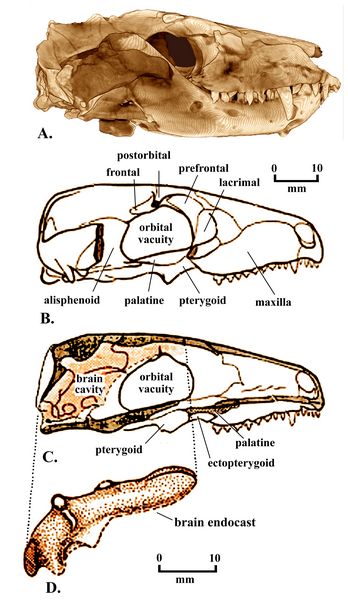Athena Review Image Archive ™
Thrinaxodon liorhinus skull & brain endocast

Thrinaxodon liorhinus (A) after Rowe, Digimorph; B-D) Kielan-Jaworski et al.2004, fig.3.2)
Thrinaxodon was a medium-sized cynodont who lived in South Africa, India, and Antarctica during the Early Triassic period (252-247 mya), during and after the Permian–Triassic mass extinction event. It is grouped in the clades Therapsida and Cynodontia, and the family Thrinaxodontidae.
Thrinaxodon was originally discovered in the Lystrosaurus Assemblage Zone of the Beaufort Group of South Africa. The type species, T. liorhinus, was named in 1894 by Seeley from the Greek for "trident tooth", thrinax- and -odon. The species name liorhinus means "smooth-nosed". In the 1960s, additional fossils of Thrinaxodon were discovered by Colbert in the Fremouw Formation of Antarctica (Colbert and Kitching 1977). Elsewhere in Gondwana, Thrinaxodon is also reported from the Damodar Valley in India (Bandyopadhyay 1999).
Thrinaxodon, about the size of a fox, was one of the few carnivores of its time, and was larger than most cynodont carnivores. The skull of Thrinaxodon shows a simplification when compared with its pelycosaurian ancestors in a reduction in the number of skull bones. Further simplification of the skull, in turn, is seen in the Late Triassic cynodont Probainognathus, compared with Thrinaxodon, which is thus seen as an important transitional fossil.
Like some other cynodonts, Thrinaxodon adopted a semi-sprawling posture, an intermediate form between the sprawling position of pelycosaurs (as in extant crocodiles) and the more upright posture of present-day mammals. This indicates a burrowing habit, which may have aided its survival during the the Permian–Triassic extinction event. The earliest fossils of burrowing Thrinaxodon, discovered in the ancient flood plains of the Karoo Basin in South Africa, date from 251 mya, the time of the extinction (Damiani et al. 2003).
The figure shows A) a computerised rendering of the Thrinaxodon skull (Digimorph, ed. Rowe); B) a labelled drawing of the skull from the right side; C) a cutaway view of the skull, showing the brain cavity; D) a brain endocast drawing, slightly enlarged (Kielan-Jaworoska et al. 2004).
References:
Bandyopadhyay, S. 1999. Gondwana Vertebrate Faunas of India. PINSA 65(8), pp.285-313
Colbert, E. and Kitching, J. 1977. Triassic Cynodont Reptiles from Antarctica. American Museum Novitates. 2611. 1-30.
Damiani, R., Modesto, S., Yates, A., Neveling, J. 2003. Earliest evidence of cynodont burrowing. Proceedings of the Royal Society of London B. 270 (1525): 1747–1751.
Kielan-Jaworoska, Z., Luo, Z-X, Cifelli, R.L. 2004. Mammals from the Age of Dinosaurs. Columbia University Press. Chapter 4.
Rowe, T. 2001. Thrinaxodon liorhinus, Fossil Cynodont. Digimorph.org.
Copyright © 1996-2020 Rust Family Foundation (All Rights Reserved).